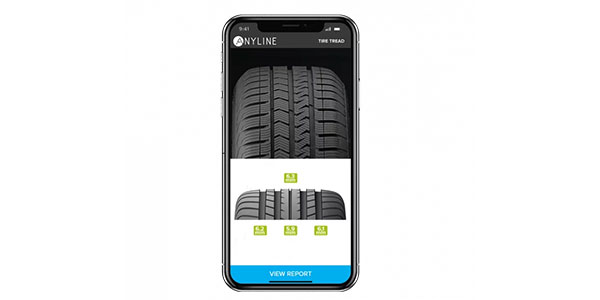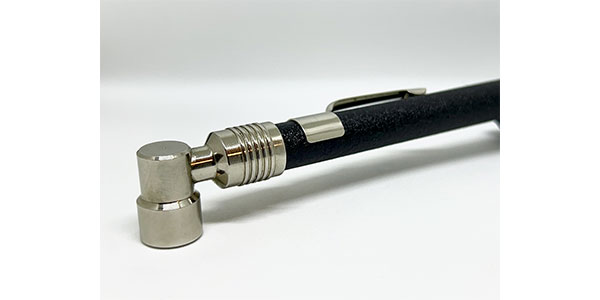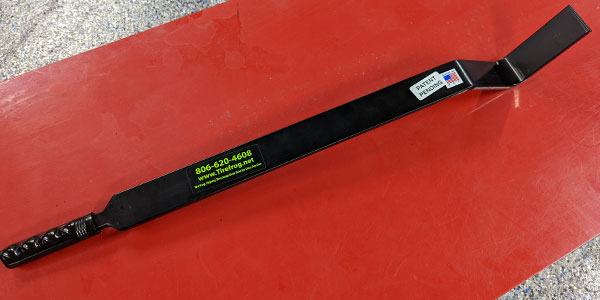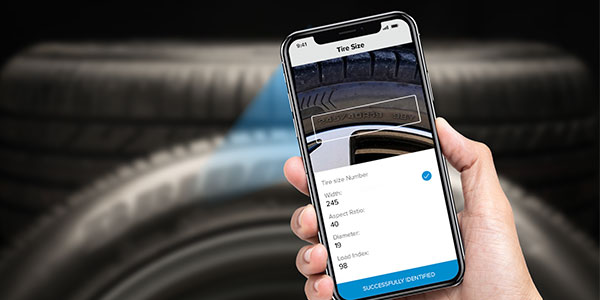When delving into the world of tread designs, one thing that is always fascinating is the size of the contact patch through which the tread design must roll.
On an average-size passenger car tire, the contact patch is about the size of a 4×6-inch postcard. In total, all four contact patches reach about the size of an 8×11-inch piece of paper.
That’s precious little rubber-to-road contact, given that the primary purpose of the tread design is to transmit tractive forces, such as braking and cornering.
The second major purpose of the tread design is to provide grip. To pull this together a bit, think of traction as being the hypotenuse of a right triangle. Think of the legs of the triangle going through a corner. The bottom of the triangle (east-west) represents lateral force (encountered in a turn) and the north-south leg (vertical force) would be braking. If you’re braking and turning, you are dealing with a tractive force or “tractive vector” in engineering terms. This is nothing more than the hypotenuse of the triangle rolling through the center of the contact patch.
Wear Patterns
Let’s look at this yet another way. Good tire techs can visually tell if the tread ribs and blocks are being unevenly worn in an east-west or side-to-side manner. They can also see a heel-and-toe wear pattern, which is more of a north-south phenomenon. All they have to do is rub their hand, gloved or not, across the tread surface to feel the jagged, high and low points of heel-and-toe wear. By doing this, they can also tell if the tires have been flatspotted.
If the problem is heel-and-toe wear, tire techs can logically assume that the cause may have something to do with a worn shock absorber, a ball joint or a bearing that’s causing the tire to move forwards and backwards in the contact patch under braking. It’s the job of a tire tech to determine if the problem is a tire issue or a vehicle maintenance issue.
Imagine a tread design that doesn’t have uniform stress distribution going into the contact patch. That usually results in one rib carrying more load than another rib. Result: One rib will wear prematurely, especially during braking or accelerating.
Void Ratios and Noise
As they go about their work, tread designers must consider many things, not the least of which is balance. They also talk about such things as the wet-dry void ratio.
The more rubber on the road, the higher the wet-dry void ratio. Most passenger car tires have a rubber-to-void ratio of 60%, meaning 60% of a contact patch is rubber on the road, and 40% is void. All street tires exhibit a certain amount of void, which are really gaps or rain channels. Water, snow or mud must be evacuated quickly, and it’s up to the tread designer to sort out all the variables before a tire is sent to market.
There is also the matter of noise, which nobody likes. Imagine holding a deck of playing cards in your hand. There are 52 cards. When you shuffle those cards through your fingers, they make a noise. Now, think of the tread blocks in a tire. If they were all arranged in the same way and were the same size, as the cards in a deck, they would roll into and out of the contact patch, striking the ground with the same force, resulting in the same noise. Loudly!
Thankfully, that’s not how tiremakers create tread designs. The size and pitch of each tread block is varied; the designer makes some tread blocks larger, others smaller and others smaller still. The size of the ribs are also varied as the tread designer works at finding the right phasing of tread-block size and shape along with varying rib configurations.
In this way, the tread designer can interfere with – or tune out – noise signals by creating a countering white noise that’s so quiet we can’t hear it. The intensity of the noise signature changes, too, according to the sizes and shapes of the blocks and how they’re placed around the tire.
Some cars have a lot of toe-in or excessive camber gain. Or, the vehicle owner hasn’t paid attention to tire pressure. In any case, a tire with heel-and-toe cupping develops a wear set and an increasing amount of noise.
When tires with heel-and-toe cupping are rotated, they roll in the other direction, meaning the leading edge of a tread block, which used to be the trailing edge, is suddenly the high spot on the tire. Now we have more noise. That’s another reason to attend to your customer’s tires on a more frequent basis. The owner of a Lexus doesn’t like noise. The owner of a BMW Z-4 will tolerate some noise, as long as it’s not excessive.
It helps to know that tread noise – the hissing and moaning we hear – is called airborne noise. This is noise that registers above 500 Hz (Hertz – abbreviated Hz – measures frequency of particle vibration as a sound wave passes through a medium. One Hz equals one vibration per second). In contrast, structure-borne noise refers to everything below 500 Hz, such as the car’s roof, which comes in at about 80 Hz and can sound like thunder if tested on its own. But a steering wheel may only have a natural resonance of 25 Hz, which is just at the threshold of hearing and barely audible.
Some customers will be able to hear noise that others cannot. For some, flying is bothersome because they can pick up the changing pressure in the cabin (about 50 Hz). One passenger will not feel the change, while another will be very sensitive to it.
A Sipe’s Role
Moving deeper into the subject, there are three flavors of tires: summer, winter and all-season. A winter tire is the extreme in terms of void and has a lot of siping. Its tread elements are less rigid, yet more aggressive because a winter tire must mechanically link with snow to provide good traction. With more biting edges and sipes, a winter tire is necessarily noisier than its counterparts.
The summer tire has a more rigid tread design, high levels of wet and dry grip and deep water capability. A summer tire puts more rubber on the road than either the all-season or winter tire. Generally, a summer tire has sipes because it must get rid of water. Sipe-wise, an all-season tread falls in between dedicated summer and winter tires.
Sipes exist because water must have a place to go. A sipe plays a temporary role as a water-storage tread design feature. It allows the tire to break the water film on the road. A layer of water on the road exhibits surface tension. Some of this water, along with air, will be stored in each sipe, and it is ejected through centrifugal force as the tire rolls through its contact patch.
Sipes result in a Catch 22, however, because the pumping action can create noise. Think of a single straight sipe surrounded by rubber, all alone in the middle of a tread block. There is no way for water or air to escape. But if the sipe is vented to a channel water, perhaps with varying depth or a zig-zag pattern, then the water and trapped air can be evacuated quickly. This gets rid of the hiss and sizzle some drivers hear.
Finally, since every road surface has its own signature, the tire and its tread elements act like the membrane on a drum. The tread design meets every bit of aggregate in the road surface as each tread element rolls through the contact patch. Think of hitting a drum with a drumstick. Noise volume goes up or down depending on the size and hardness of the drumstick or, in the case of a tire, the surface aggregate of the road.
These are basic mechanics and environment at play, and the tread designer must deliver the goods while still providing uniform wear and a hot looking tire. That expertise distinguishes today’s tires from those of 40 years ago.








